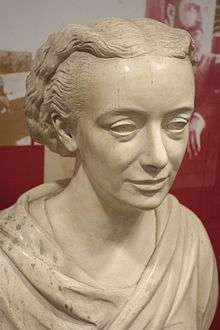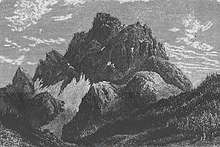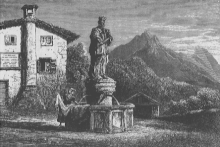Amelia Edwards
Amelia Ann Blanford Edwards (7 June 1831 – 15 April 1892), also known as Amelia B. Edwards,[1] was an English novelist, journalist, traveller and Egyptologist. Her successful literary works included the ghost story "The Phantom Coach" (1864), the novels Barbara's History (1864) and Lord Brackenbury (1880), and the Egyptian travelogue A Thousand Miles up the Nile (1877). In 1882, she co-founded the Egypt Exploration Fund. She also edited a poetry anthology published in 1878.[2]
Amelia Edwards | |
|---|---|
 Amelia B. Edwards in 1890 | |
| Born | 7 June 1831 London, United Kingdom |
| Died | 15 April 1892 (aged 60) Weston-super-Mare, United Kingdom |
| Resting place | St Mary's Church, Henbury |
Early life

Born in London to an Irish mother and a father who had been a British Army officer before becoming a banker, Edwards was educated at home by her mother and showed early promise as a writer. She published her first poem at the age of seven and her first story at the age of twelve. Thereafter came a variety of poetry, stories, and articles in several periodicals, including Chambers's Journal, Household Words, and All the Year Round. She also wrote for the Saturday Review and the Morning Post.[4][5]
In addition, Edwards became an artist and would illustrate some of her own writings. She would also paint scenes from other books she had read.[6] She was talented enough at the age of 12 to catch the eye of George Cruikshank, who went as far to offer to teach her, but this talent was not supported by Edwards's parents, who saw it as a lesser profession and the artist way of life as scandalous.[7] This negative decision haunted Edwards through her early life. She would wonder frequently whether art would not have been her true calling.[8]
Thirdly, Edwards took up composing and performing music for some years, until she suffered a bout of typhus in 1849 that was followed by a frequently sore throat. This made it hard for her to sing, causing her to lose interest in music and even regret the time she had spent on opera.[6] Other interests she pursued included pistol shooting, riding and mathematics.[7]
Fiction
Early in the 1850s, Edwards began to focus more exclusively on being a writer.[9] Her first full-length novel was My Brother's Wife (1855). Her early novels were well received, but it was Barbara's History (1864), a novel involving bigamy that established her reputation. She spent much time and effort on the settings and backgrounds of her books, estimating that it took her about two years to complete the research and writing of each. This paid off when her last novel, Lord Brackenbury (1880), went to 15 editions.
Edwards wrote several ghost stories, including the frequently anthologised "The Phantom Coach" (1864).[4][5] The background and characters in many of her writings are influenced by personal experiences. For example, Barbara's History (1864) uses Suffolk as the background, which she had visited for a few enjoyable summer holidays as a child.[8]
Dolomites

Edwards first heard about the Dolomites in 1853, through sketches brought back to England from Italy. On 27 June 1872, she embarked on a trip through the mountains with her friend Lucy Renshawe.[8][6][10] That day they left Monte Generoso for Venice, one of the three known ways to enter the Dolomites, but not before parting from Renshawe's maid and courtier, who disapproved of such a journey.[10] Instead the two women hired mountain guides from the region.[8] On 1 July 1872, after a three-day stay in Venice, Edwards and Renshawe left for Longarone, Cortina d'Ampezzo, Pieve di Cadore, Auronzo di Cadore, Val Buona, Caprile, Agordo, Primiero, Predazzo, Fassa Valley, Passo Fedaia, Sasso Bianco, Forno di Zoldo, Zoppè di Cadore and Caprile, and ended their journey in Bolzano.[10] At the time of Edwards's visit, the Dolomites were described as terra incognita, and even educated persons had never heard of them.[8] This journey was described in her book A Midsummer Ramble in the Dolomites (1873), later entitled Untrodden Peaks and Infrequent Valleys (1873).[6] During the expedition, Edwards also sought works of Titian, finding a Madonna and Child in Serravalle (Vittorio Veneto) and two other paintings at a village church in Cadore.[9] After her descent from the mountains, Edwards described civilized life as a "dead-level World of Commonplace".[8]
In the summer of 1873, dissatisfied by the end of their journey, Edwards and Renshawe took to a walking tour of France.[8] However, this was interrupted by torrential rains, a factor that influenced them in looking towards Egypt.[6]
Egypt

_-_TIMEA.jpg)
Edwards, again accompanied by Lucy Renshawe, toured Egypt in the winter of 1873–1874, experiencing a fascination with the land and its cultures, ancient and modern. Journeying southwards from Cairo in a hired dahabiyeh (manned houseboat), the two women visited Philae and ultimately reached Abu Simbel, where they remained for six weeks.[11] Another party member was the English painter Andrew McCallum, who discovered a sanctuary that came to bear his name for some time afterwards.[12] Their boat joined a flotilla with another female English traveller, Marianne Brocklehurst, also travelling with a female companion. Brocklehurst and Edwards remained friends and Brocklehurst later supported her Egypt Exploration Fund.
Edwards wrote a description of her Nile voyage entitled A Thousand Miles up the Nile (1877).[13][14] This self-illustrated travelogue was an immediate success.
Edwards' travels in Egypt made her aware of increasing threats to ancient monuments from tourism and modern development. She set out to hinder these through public awareness and scientific endeavour, becoming an advocate for research and preservation of them. In 1882, she co-founded the Egypt Exploration Fund with Reginald Stuart Poole, Curator of the Department of Coins and Medals at the British Museum. Edwards became joint Honorary Secretary of the Fund until her death.
_-_TIMEA.jpg)
To advance the Fund's work, Edwards largely abandoned other writing in favour of Egyptology. She contributed to the 9th edition of the Encyclopædia Britannica,[15] to the American supplement of that, and to the Standard Dictionary. In addition, Edwards took on an strenuous lecture tour in the United States in 1889–1890. The lectures later appeared as Pharaohs, Fellahs and Explorers.[16]
Death and legacy
%2C_Egypt._From_the_Amelia_Edwards_Collection._The_Petrie_Museum_of_Egyptian_Archaeology%2C_London.jpg)
After catching influenza, Edwards died on 15 April 1892 at Weston-super-Mare, having lived at Westbury-on-Trym, near Bristol, since 1864.[17][18] She was buried in the churchyard of St Mary the Virgin, Henbury, Bristol, where her grave is marked by an obelisk with a stone ankh at the foot. Alongside are the graves of her life partner of 30 years, Ellen Drew Braysher (9 April 1804 – 9 January 1892), with whom she had lived in Westbury-on-Trym, and of Ellen's daughter, Sarah Harriet Braysher (1832–1864). In September 2016, Historic England designated the grave Grade II listed,[19] as a landmark in English LGBT history.[20]
Edwards bequeathed her collection of Egyptian antiquities and her library to University College London, with a sum of £2,500 to found an Edwards Chair of Egyptology.[21] Edwards also supported Somerville College Library, having left many books, papers and watercolours to Somerville College, Oxford, along with a small collection of Greek and Roman pots.[22]
In popular culture
- In 2012, Edwards was portrayed as a non-singing character in Stephen Medcalf's production of Aida at London's Royal Albert Hall.[23] The opera opens with a Victorian "dig" among Egyptian tombs, and the action unfolds as Edwards imagines the plot taking place based on her exploration of the site.[24] The libretto was based on a scenario by the Egyptologist Auguste Mariette, a contemporary of Edwards.[25]
- The Egyptologist and novelist Elizabeth Peters (Barbara Mertz) named her character Amelia Peabody after Amelia Edwards.[26]
- In 2014, a new music ensemble, Alarm Will Sound, staged a music-theatre piece, I Was Here I Was I, based on Amelia Edwards's A Thousand Miles Up the Nile, at the Temple of Dendur in the Metropolitan Museum of Arts' Sackler Wing. It was written and directed by Nigel Maister to music by Kate Soper.[27]
- A one-woman show based on Edwards's life, Hers Was the Earth, by Kim Hicks, was performed at the Petrie Museum during the 2011 International Women's Day observances.[28]
Bibliography
History and archaeology
- A Summary of English History: from the Roman Conquest to the present time, 1856
- Outlines of English history: from the Roman conquest to the present time: with observations on the progress of art, science, and civilization, and questions adapted to each paragraph: for the use of schools (c. 1857)
- The History of France; from the Conquest of Gaul by the Romans to the Peace of 1856, 1858
- The Story of Cervantes, etc., 1862
- A Thousand Miles Up the Nile London: George Routledge and Sons Ltd, 1877 (1st edition) and 1890 (2nd edition, ISBN 0-9819284-2-0)[29]
- Pharaohs, Fellahs, and Explorers. New York: Harper & Brothers, 1891
Novels
- My Brother's Wife. A life–history, 1855
- The Ladder of Life. A heart history, 1857
- The Young Marquis, or, a story from a Reign, c. 1857
- The Eleventh of March. (From a pocket-book of forty years ago), 1863
- No Hero: an Autobiography, 1863[30]
- Barbara's History, 1864
- Hand and Glove. A tale, 1865
- Miss Carew (short stories), 1865
- Half a Million of Money, c. 1868
- Debenham's Vow, 1870
- Monsieur Maurice, and other stories, 1873; contains the stories:[31]
- "Monsieur Maurice"
- "An Engineer's Story"
- "The Cabaret of the Break of Day"
- "The Story of Ernst Christian Schoeffer"
- "The New Pass"
- "A Service of Danger"
- "A Night on the Borders of the Black Forest"
- "The Story of Salome"
- "In the Confessional"
- "The Tragedy in the Palazzo Bardell"
- "The Four Fifteen Express"
- "Sister Johanna's Story"
- "All Saints' Eve"
- In the Days of My Youth, 1873
- Lord Brackenbury, 1880
- The Phantom Coach, by Amelia B. Edwards, adapted by I. M. Richardson, illustrated by Hal Ashmead, c. 1982
Poetry
- Ballads. London: Tinsley, 1865
- A Poetry-book of Elder Poets, consisting of songs & sonnets, odes & lyrics, selected and arranged, with notes, from the works of the elder English poets, dating from the beginning of the fourteenth century to the middle of the eighteenth century. 1878
Translations
- Manual of Egyptian Archaeology and Guide to the Study of Antiquities in Egypt: for the use of students and travellers by Sir G. Maspero, translated by Amelia B. Edwards
Travel
- Sights and Stories: being some account of a Holiday Tour through the north of Belgium, 1862
- A Thousand Miles up the Nile, 1877
- Untrodden Peaks and Unfrequented Valleys: A Midsummer Ramble in the Dolomites. London: Longman's, Green, and Co., 1873
Source: catalogue of the British Library
See also
Biographies
- Manley, Deborah (2015). Oxford Dictionary of National Biography entry.[6]
- Adams, Amanda (2010). Ladies of the Field. Greystone Books.
- Moon, Brenda E. (2006). More usefully employed: Amelia B. Edwards, writer, traveller and campaigner for ancient Egypt. London: Egypt Exploration Society.
- Rees, Joan (1995). Women on the Nile: Writings of Harriet Martineau, Florence Nightingale, and Amelia Edwards. Rubicon Press.
- Rees, Joan (1998). Amelia Edwards: traveller, novelist & Egyptologist. London: Rubicon Press.
References
- "Author Profile". Goodreads.
- A Poetry-book of modern poets.
- Edwards, Amelia (1873). Untrodden Peaks and Unfrequented Valleys. London: Green and Co.
- Bleiler, E. F. (1986). "Edwards, Amelia B.". In Sullivan, Jack (ed.). The Penguin Encyclopedia of Horror and the Supernatural. New York: Viking. p. 140. ISBN 0-670-80902-0.
- Benjamin F. Fisher IV (1985). "Amelia B. Edwards". In Bleiler, E. F. (ed.). Supernatural Fiction Writers. New York: Scribner's. pp. 255–260. ISBN 0-684-17808-7.
- "Edwards, Amelia Ann Blanford". Oxford Dictionary of National Biography (online ed.). Oxford University Press. doi:10.1093/ref:odnb/8529. (Subscription or UK public library membership required.)
- Jenkins, Ruth Y. (2007). "More Usefully Employed: Amelia B. Edwards, Writer, Traveler and Campaigner for Ancient Egypt". Victorian Studies. 49: 365–367. doi:10.2979/VIC.2007.49.2.365 – via Indiana University Press.
- Rees, Joan (1998). Amelia Edwards Traveller, Novelist & Egyptologist. London: The Rubicon Press. pp. 25–31.
- O'Neill, Patricia (2009). "Destination as Destiny". Frontiers: A Journal of Women Studies. 30: 52–53. doi:10.1353/fro.0.0048 – via Project MUSE.
- Edwards, Amellia (1890). Untrodden Peaks and Unfrequented Valleys. London: George Routledge and Sons.
- O'Neill, Patricia (2009). "Destination as Destiny". Frontiers: A Journal of Women Studies. 30: 52–53 – via Project MUSE.
- Edwards, Amelia B. (1891). A Thousand Miles Up the Nile. London: G. Routledge & Sons.
- Edwards, Amelia B. (1877). A Thousand Miles up the Nile (Second ed.). London: Longmans.
- Edwards, Amelia B. A Thousand Miles up the Nile.
- Edwards, Amelia B. (1884). "Mummy". Encyclopædia Britannica. XVII (9th ed.).
- Edwards, Amelia B. (1891). Pharaohs, Fellahs and Explorers (online ed.). New York: Harper & Brothers.
- Matthew, H. C. G & Harrison, Brian, eds. (2004). Oxford Dictionary of National Biography. New York: Oxford University Press. pp. 908–909. ISBN 0-19-861367-9.CS1 maint: uses authors parameter (link)
- Rees, Joan (1998). Amelia Edwards: Traveller, Novelist and Egyptologist. London: Rubicon Press. pp. 19 and 66. ISBN 0-948695-61-7.
- Historic England. "Grave of Amelia Edwards (1439170)". National Heritage List for England. Retrieved 24 September 2016.
- "'Queer history' landmarks celebrated by Historic England". BBC News. 23 September 2016. Retrieved 24 September 2016.
- Rees, Joan (1998). Amelia Edwards: Traveller, Novelist and Egyptologist. London: Rubicon Press. p. 69. ISBN 0-948695-61-7.
- "Special Collections". some.ox.ac.uk. Retrieved 28 August 2018.
- Hall, George (24 February 2012). "Aida – review". The Guardian. Retrieved 28 January 2014.
- Christiansen, Rupert (24 February 2012). "Aida, Royal Albert Hall, review". The Daily Telegraph. Retrieved 28 January 2014.
- Sadie, Stanley; Macy, Laura, eds. (2009). "Aida". The Grove Book of Operas. Oxford: Oxford University Press. p. 9. ISBN 978-0-19-538711-7.
- "Frequently Asked Questions about MPM". MPMBooks.com. Archived from the original on 3 July 2015.
- New York Times
- Heritage-key.com
- Edwards, Amelia B. (1890). A Thousand Miles up the Nile. Norton Creek Press (Second ed.). Routledge & Sons.
- Classed as a novel by the British Library Retrieved 1 November 2018.
- WorldCat.org library listing. OCLC 8602995.
External links
| Wikimedia Commons has media related to Amelia Edwards. |
| Wikisource has the text of the 1911 Encyclopædia Britannica article Edwards, Amelia Ann Blandford. |
- Online books, and library resources in your library and in other libraries about Amelia Edwards
- Online books, and library resources in your library and in other libraries by Amelia Edwards
- Works by Amelia Edwards at Project Gutenberg
- Works by or about Amelia Edwards at Internet Archive
- Works by Amelia Edwards at LibriVox (public domain audiobooks)

- "Amelia Edwards biography". UPenn Digital Library.
- "A Celebration of Women Writers". UPenn Digital Library.
